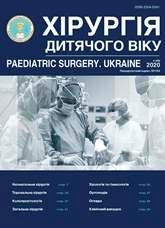Use of the cutaneous-subcutaneous-fascial rotational flap on nutrition branch for covering surface defects in children
DOI:
https://doi.org/10.15574/PS.2020.69.51Keywords:
cutaneous-subcutaneous-fascial flaps, superficial defects, childrenAbstract
Introduction. Diseases that are accompanied by significant cutaneous-subcutaneous-fascial defects during surgery in children include: pilonidal cyst (PC), spinal hernia (SH), Fournier’s gangrene and wounds. Various methods of surgical treatment of PC consist of the stages: removal of the cyst and covering the wound surface with suturing or leaving the wound surface open. The existing methods of covering a defect in SH in children cannot satisfy surgeons, because they are accompanied by significant tissue tension, which causes complications. Fournier’s gangrene in children is a rare disease with a large area of soft tissue damage. Initial surgical debridement of wounds in childhood requires an individual approach with the choice of the correct method to close the defect.
Purpose. To study the possibilities of using the rotation of vascularized cutaneous-subcutaneous-fascial flap (CSFF) for the surgical treatment of superficial defects in children.
Materials and methods. The surgical treatment of superficial defects in 73 children in a City Children’s Hospital (Chernivtsi) with PC (29 children), SH (20 children), wounds of the face, limbs and trunk (23 children), Fournier gangrene (1 child) was analyzed. We compared the performing of traditional methods of treatment and rotational methods of using CSFF. Recovery time and postoperative complications were analyzed.
Results. By using traditional methods of treating PC, complications were observed in 50%, when using the proposed plastic surgery with rotational CSFF in 6.67%; in case of SH – in 44.44% and 18.18%, with wounds – in 27.27% and 8.33%, respectively. Plastic reconstruction in Fournier’s gangrene recovered on the 40th day of the postoperative period.
Conclusion. The use of cutaneous-subcutaneous-fascial rotational flap with perforating vessels surgery allows to reduce the amount of complications after operations for PC, SH, initial surgical debridement of wounds, Fournier’s gangrene.
The research was carried out in accordance with the principles of the Helsinki Declaration. The study protocol was approved by the Local Ethics Committee of participating institution.
References
Bodnar O, Roshka A, Vatamanesku L et al. (2020). Spinal Dysraphism of Lumbosacral Area in Infants: Aspects of Surgical Treatment. J Pediatr Neonatal. 2(1): 1–6.
Bordakov PV, Bordakov VN, Gain YuM, Shakhrai SV, Gain MYu. (2017). Fournier's gangrene: clinic, diagnostics, treat-ment. Wounds and Wound Infections. The Prof. B.M. Kostyuchenok Journal. 4(1): 14-23. https://doi.org/10.17650/2408-9613-2017-4-1-14-23
Cymbalyuk VI, Luzan BN, Tatarchuk MM. (2013). Prichiny povtornyh operacij pri travme nervov verhnih i nizhnih konechnostej. Mezhdunarodnyj nevrologicheskij zhurnal. 4 (58): 11-14.
Duman K, Gırgın M, Harlak A. (2017). Prevalence of sacrococcygeal pilonidal disease in Turkey. Asian Journal of Surgery. 40: 434-437. https://doi.org/10.1016/j.asjsur.2016.04.001; PMid:27188235
Farrell D, Murphy S. (2011). Negative pressure wound therapy for recurrent pilonidal disease: a review of the literature. J Wound Ostomy Continence Nurs. 38: 373-378. https://doi.org/10.1097/WON.0b013e31821e5117; PMid:21606863
Kim JT. (2005). New nomenclature concept of perforator flap. Br J Plast Surg. 58(4): 431-440. https://doi.org/10.1016/j.bjps.2004.12.009; PMid:15897023
Mustafa Kurşat Evrenos, Haldun Onuralp Kamburoğlu, Mehmet Secer, Kadir Cınar, Mehmet Dadacı5, Bilsev İnce. (2017). Clinical Outcomes of Large Meningomyelocele Defect Repair by Bilateral Fasciocutaneous Rotation and Advancement Flaps with Perforators. Turkish Journal of Plastic Surgery. Turk Plastik Rekonstruktif ve Estetik Cerrahi Dergisi. 25(3): 113-119. https://doi.org/10.5152/TurkJPlastSurg.2017.2144
Pini Prato A, Mazzola C, Mattioli G et al. (2018). Preliminary report on endoscopic pilonidal sinus treatment in children: results of a multicentric series. Pediatric Surgery International. 34(6): 687-692. https://doi.org/10.1007/s00383-018-4262-0; PMid:29675752
Downloads
Published
Issue
Section
License
The policy of the Journal “PAEDIATRIC SURGERY. UKRAINE” is compatible with the vast majority of funders' of open access and self-archiving policies. The journal provides immediate open access route being convinced that everyone – not only scientists - can benefit from research results, and publishes articles exclusively under open access distribution, with a Creative Commons Attribution-Noncommercial 4.0 international license(СС BY-NC).
Authors transfer the copyright to the Journal “PAEDIATRIC SURGERY.UKRAINE” when the manuscript is accepted for publication. Authors declare that this manuscript has not been published nor is under simultaneous consideration for publication elsewhere. After publication, the articles become freely available on-line to the public.
Readers have the right to use, distribute, and reproduce articles in any medium, provided the articles and the journal are properly cited.
The use of published materials for commercial purposes is strongly prohibited.

